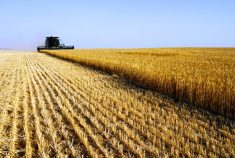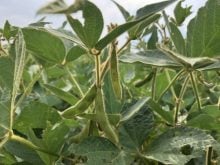MarketsFarm — Extreme heat and drought throughout most of Argentina have taken a huge toll on that country’s soybean crop.
Dr. Michael Cordonnier of Soybean and Corn Advisor said the forthcoming soybean harvest is now likely to produce 25 million to 30 million tonnes, a far cry from the 40 million to 45 million tonnes several analysts initially projected.
“They’re going from worse to worser in Argentina,” Cordonnier said, noting the country experienced temperatures in the 40 C range for the last 10-15 days.
“It’s really hit the early-planted soybeans and the early-planted corn,” he added.
Read Also

U.S. grains: CBOT soybeans, corn, wheat fall in USDA data aftermath
Chicago grains took a dive on Friday, following a closely watched U.S. government crop report and the release of export data that could provide clues into Chinese buying.
Why it matters: Argentina is typically one of the world’s biggest exporters of soymeal and soyoil, so the fate of its soybean crop often looms large over North America’s oilseed markets.
Of Argentina’s corn, Cordonnier surmised it’s not quite as bad off as the soybeans, with expectations of 35 million to 40 million tonnes to be harvested. Initial hopes had called for well in excess of 50 million tonnes.
“The later-planted crops are going to do better,” he pointed out.
Soybeans were thrown an unexpected curveball in mid-February when Argentina was hit with a summertime frost. Cordonnier said the top third on soybean plants was hit with the brunt of the damage, essentially killing off that portion and leaving no hope of a recovery.
As bad as Argentina’s drought has been this crop year, Cordonnier said a good rain would help the situation to an extent.
“With two inches on the corn, you would probably stabilize it. Two inches on the beans, it would still be kind of hard pressed,” he said.
Another element to Argentina’s increasingly dismal soybean crop is the amount estimated to be abandoned. Cordonnier noted the Rosario Grain Exchange projected more than 6.4 million acres, 15 to 17 per cent of the planted soybean area, will very likely be abandoned. As for corn, the exchange estimated 1.2 million to 1.7 million acres are likely to suffer the same fate.
And the sad story doesn’t stop there, Cordonnier said. Farmers have been demanding the Argentine government institute another soybean exchange program. Earlier this crop year the government enacted a ‘soy dollar’ program offering a preferential exchange rate on foreign currency brought in by way of soybean exports.
“But that’s going be very hard to do because that prior program incentivized exports. The crushers in Argentina already can’t find enough soybeans to crush. It’s just a real dilemma in Argentina,” he said, noting there’s already imports been imports coming from Brazil.
As for Argentina’s northern neighbour, Cordonnier pegged Brazil’s soybean output at 151 million tonnes, but with potential to go lower. Dryness in the State of Rio Grande do Sul could be the catalyst for cutting future estimates, he said.
Cordonnier said he’s also wary of Brazil’s second corn crop because it’s been planted so late that it runs the risks of frost and dry weather.
— Glen Hallick reports for MarketsFarm from Winnipeg.















